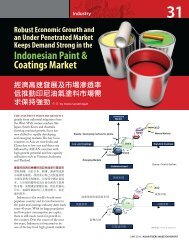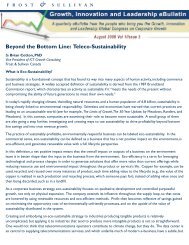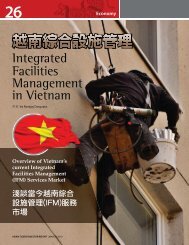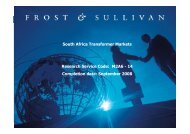Executive Interview_PDS09.pdf - Growth Consulting - Frost & Sullivan
Executive Interview_PDS09.pdf - Growth Consulting - Frost & Sullivan
Executive Interview_PDS09.pdf - Growth Consulting - Frost & Sullivan
You also want an ePaper? Increase the reach of your titles
YUMPU automatically turns print PDFs into web optimized ePapers that Google loves.
<strong>Executive</strong> <strong>Interview</strong><br />
GE's Successful Innovations: Imagination Breakthroughs<br />
An interview with<br />
Patia McGrath<br />
Global Director Innovation<br />
and Strategic Connections<br />
General Electric Company<br />
The Global Director of Innovation and Strategic Connections for GE, Patia McGrath, was interviewed about the<br />
company's successful innovations by Ethan Smith, Director of NA Sales for the Technical Insights Group at<br />
<strong>Frost</strong> & <strong>Sullivan</strong>.<br />
Ethan:<br />
I’ve heard the term "imagination breakthrough" used to identify GE's successful innovations. Can you<br />
explain what an "imagination breakthrough" is and to what extent is GE relying on these<br />
"breakthroughs" for long term growth?<br />
Patia:<br />
The Imagination Breakthrough (IB) program has been in place since 2003 and currently has about 50 projects in its<br />
portfolio. Jeff Immelt actively tracks this collection of organic growth projects, and because of this CEO spotlight, we<br />
often say that they are also a protected class of ideas.<br />
All of our businesses have IBs, and Jeff’s keen interest helps to make sure they are resourced and executed. These<br />
innovations are expected to generate at least $100 million in incremental organic growth revenue within an timeframe<br />
appropriate to the project, but from there the similarities between IB projects end. IBs are shining examples of the<br />
diversity of ways GE approaches innovation -- they come in all shapes and sizes, and they each pursue innovation in<br />
their own way. Some of the projects are technical innovations, whereas some are wholly commercial innovations – an<br />
IB might present an entirely new business model of innovation, for example. But they all serve as wonderful<br />
illustrations, both internally and externally, as to how GE is innovating to reach its organic growth goals and to<br />
position our company for long-term success.<br />
Ethan:<br />
Many people believe you must be small and nimble to be considered an innovative company. How does<br />
GE, a company with $173 billion in annual revenues, continue to be innovative?<br />
Patia:<br />
Certainly GE is a big ship to steer, but no matter if you are a small company or a large one, being innovative means<br />
having customers and their needs at the heart of everything you do. GE actively works to ensure that our scale works
to our advantage in how we approach innovation. Some of that advantage reveals itself on the learning front – we do<br />
a tremendous about of best practice sharing between businesses. That means a business –say Healthcare – that has<br />
experience with a customer insight technique like ethnography might end up mentoring another business – say<br />
Security – as they give the methodology a try. But our scale also uniquely positions GE to act on those customer<br />
insights. The expansive capabilities and technologies available across the breadth of our businesses enable us to<br />
innovate solutions for customers holistically and compellingly. Our efforts in areas like desalination, and similar<br />
opportunities in emerging markets, prove that size and heft absolutely equates to innovation.<br />
Ethan:<br />
Many companies partner with universities, government bodies and sometimes even other companies<br />
to foster innovation. In what types of partnerships does GE participate and which ones do you believe<br />
produce the greatest results?<br />
Patia:<br />
Partnerships are not new to GE – I would point to our Aviation business’ long-standing partnership with Scnema as a<br />
highly successful proof point of this – but as we look to innovate even more in what we call “adjacencies” and<br />
“whitespace,” we know that partnerships will be critical in our ability to execute and win in these arenas. We are<br />
breaking the “not invented here” mindset – we are excited to tap into the talented people and terrific ideas outside of<br />
GE that will enable our customers’ needs to be addressed better and faster than ever before. We consider the full<br />
spectrum of types of alliances – be it a simple contract or a full-blown JV – whatever form is most appropriate for the<br />
innovation at hand. No matter what form the partnership takes though, or no matter what type of entity you are<br />
partnering with – having laid out the common goals, expectations, and ground rules is critical for success. The hardest<br />
part, and most important part, of the partnership process kicks in after the agreement is signed – that is when the real<br />
work begins! But overall, we are actively looking to use partnerships as enablers to assist us in innovating and cocreating,<br />
both for short-term success but also for laying the groundwork for success in the future.<br />
Ethan:<br />
Quick question around innovation process or result of it - how do you or how does GE prevent the<br />
erosion of creativity when creating a formal innovation process?<br />
Patia:<br />
I can’t put my finger on the reason, but some people mistakenly assume that a company with a rich engineering and<br />
process culture like GE has means that the company can’t be creative. At GE, the complete opposite is true – I am<br />
continually blown away by the creativity I see in our company – no matter if it is during a brainstorming session or if it<br />
manifests itself in a fantastic new commercial offering. GE has no shortage of great ideas…sometimes it even feels like<br />
we have too many, since it can be so tough to choose where to start! That is where process can be very helpful, and<br />
facilitate our making thoughtful and deliberate choices about which of these great ideas to pursue first, and to do this<br />
in a consistent way. We don’t hamper creativity on the front end – we want to bubble up both incremental and radical
ideas – but we do think that having guidelines and guardrails around prioritization and filtering is an important<br />
ingredient in making sure the best ideas are those which rise to the top and flourish.<br />
Ethan:<br />
With a company as diverse as GE, how important is it for a particular innovation to impact a majority<br />
of the businesses rather than just one?<br />
Patia:<br />
More and more, I am seeing that our best innovation ideas are cross-business ideas – this is fast becoming the rule and<br />
not the exception. Certainly, we are always on the lookout for great ideas that leverage the collective power of GE.<br />
But it is really customer need and insight that is at the heart of this cross-business momentum. No matter if the<br />
customers are individual corporations, vertical industries – like mining or construction, or even countries, customers<br />
are looking for solutions that require multiple parts of GE to provide and execute on. In parallel, it is also interesting<br />
to note that there is a lot of academic research out there pointing to the fact that the future of innovation lies at the<br />
intersection of different disciplines and areas of expertise. At GE, we are frequently finding ourselves at this synergistic<br />
crossroads in innovation development. That said, of course we will embrace compelling innovations that fit neatly<br />
under the umbrella of just one business! But it does appear GE is well positioned to act on the ever-evolving,<br />
sophisticated requirements of customers that increasingly require skills and technological contributions from multiple<br />
businesses to fulfill.<br />
Ethan:<br />
Getting back to your comment about the mining and construction opportunities or at least the need<br />
in those spaces, is there direction from the top sometimes to dictate which applications the<br />
innovations must suit?<br />
Patia:<br />
Strategic priorities do come from the top, and we want our innovation portfolio to reflect those priorities and to help<br />
pave the path towards realizing our strategic goals. Imagination Breakthroughs are actively aligned to our strategic<br />
priorities. It is Jeff Immelt himself who selects which IB projects he feels should be part of our Corporate IB portfolio<br />
and which merit his focused attention. This translates to an IB portfolio that – very purposely, by design -- illustrates<br />
our company’s strategy and growth trajectory through living project examples.<br />
Ethan:<br />
I guess I’ll follow onto that with the remarks regarding Beijing. How has globalization affected GE’s<br />
ability to innovate?<br />
Patia:<br />
It is almost impossible to separate the two -- innovation and globalization are often referred to in the same sentence<br />
throughout GE. Globalization has not so much affected our ability to innovate as it has provided a breathtaking
amount of opportunities to do so. Executing on those opportunities can sometimes be tricky – we have certainly<br />
learned that the old way of doing things, where we might have assumed one size fits all, or that simply “defeaturing” a<br />
product for an emerging market was sufficient, is no longer going to cut it. The more globalized the world becomes,<br />
the more localized GE needs to be from an innovation standpoint -- we need to closer to our customer than ever, and<br />
accordingly approach innovation and design from an in-country for-country perspective.<br />
Ethan:<br />
I’ll take one of your remarks about the customers. How does GE incorporate customer insight into the<br />
innovation process?<br />
Patia:<br />
It is not an innovation process if customer insight is not embedded in it! Customer insight must be part of the<br />
skeletal foundation of the innovation process. At GE, we intentionally do not rely on one type of customer insight<br />
gathering method. Instead, we use a variety of methods and practices. For example, the tried-and-true ‘voice of the<br />
customer’ methodology has been a part of our operating rhythm for a long time now. I would point to our Energy<br />
business as one that has deeply-rooted expertise in this process…expertise that they are more than willing to share<br />
via best practices throughout the company, by the way. Ethnography is another approach that we have been<br />
successfully working with for some time now. Our Healthcare business has been a rockstar around successfully<br />
employing this technique. In fact, one of their IB project teams – Carestations -- had ethnography at the core of their<br />
customer insight gathering experience. They started by trailing anesthesiologists and their patients, to get deep<br />
understanding of their experiences and procedures. But what was especially terrific was that their ethnographic<br />
journey went beyond the hospital doors – and right into an airplane hangar, believe it or not! The team went there to<br />
observe and speak with airplane pilots. Like anesthesiologists in the hospital, airplane pilots in their cockpits find<br />
themselves processing a tremendous amount of important data, dealing with very advanced technical equipment, and<br />
also responsible for the care of people that could be in life or death situations. Such inputs and insights enabled<br />
Healthcare to reap dividends when developing the Carestation product. So, bottom line – customer insights are part<br />
of the DNA of our innovation process, and we leverage a variety of ways to tap into those insights.<br />
Ethan:<br />
Now when looking at where to invest or where to innovate and put resources how does GE decide<br />
whether to invest in a white space or adjacent area or to stay close to it’s core?<br />
Patia:<br />
We actually have a very simple, but highly effective, innovation portfolio management tool that we have creatively<br />
named the “Innovation 9-Blocker.” This lays out for us, in plain vanilla terms, the notions of core, adjacencies and white<br />
space. As basic as it sounds, leveraging a common template with shared vocabulary has proven to be very useful. By<br />
plotting current and planned innovation initiatives on this 9-Blocker, businesses can quickly see where and how they<br />
are placing their bets. It may reveal that they are over-weighted in the core and need to push out of their comfort
zone, or it could illustrate that they are taking too many big swings. This is not to say that allocations should be evenly<br />
divided -- certainly you want your core to be healthy, and incremental innovation is a critical part of maintaining a<br />
healthy core -- but we do recognize that we need to make disciplined, focused bets in adjacencies and whitespace as<br />
well. The 9-blocker also helps to facilitate discussions about risks, innovation measurement, and the like, in addition to<br />
resource allocation. It has proven to be a wonderful addition to our innovation arsenal, especially in making sure we<br />
are positioning ourselves properly for future growth.<br />
Ethan:<br />
Now not every idea or invention is going to lead to a breakthrough or even a product, how and when<br />
does GE decide that a particular idea or invention will not become a successful innovation?<br />
Patia:<br />
Really it is the customers who decide if something should become a “successful innovation” or not! But in the spirit<br />
of your question, I will underscore that in most companies, large or small, it is very difficult to kill projects. This can be<br />
due to a myriad of reasons, and I think I have seen them all! Sometimes it can be due to an emotional attachment<br />
from the project team, sometimes it may be a long-standing customer asking to keep the project going, or sometimes<br />
it may be a disconnect in understanding between the needs of past priorities versus those of future strategic direction.<br />
From a New Product Introduction (NPI) perspective, each business typically has their own milestone or tollgate<br />
processes, and this is often important in helping to make sure that projects are advancing properly. Such processes<br />
will have “kiss or kill” decision points built in. To look at this from another perspective, I would return to the example<br />
of our Imagination Breakthrough program. Jeff Immelt deep dives on a subset of IBs in the portfolio on a monthly<br />
basis. These sessions, which include, in addition to Jeff, the IB leaders, our CMO, oftentimes our SVP of Global<br />
Research, and other insight-rich participants, are intended to be discussions, not report-outs. Every IB project is an<br />
experiment of sorts, and that means these monthly reviews need to be problem-solving sessions, not problem-hiding<br />
sessions. IB leaders are encouraged to be extremely candid in these discussions – they need to provide an honest<br />
“health assessment” on the IB project’s technical progress or go-to-market progress, material changes in the external<br />
environment, and so forth. This creates an opportunity in an IB review for strategic decisions to be made, and it may<br />
well turn out that it does not make sense for the project to be an IB anymore. But it does not end there! It is also<br />
our job to make sure that, whatever lessons we learned along the way with that particular IB, we share them more<br />
widely as well. So even if a project comes off the list, we can still get success and value out of the project through the<br />
learning dimension, even without a formal commercialization of that IB.<br />
Ethan:<br />
A couple questions around personnel, does GE screen for innovators in its hiring process and if so, can<br />
you share with me an example of a trait that you would look for?<br />
Patia:<br />
At GE, not only do we encourage the ‘one GE’ approach by business, but we also encourage it by function. For
example, marketing works very closely with HR. Several years ago, HR developed what we call the ‘growth traits.’<br />
These traits, as you can guess by the label, are very much in lockstep with marketing’s mandate to evolve GE into<br />
being a more market backed company, a more customer driven company, and one that is focused on organic growth.<br />
The growth traits are: External Focus, Clear Thinking, Imagination, Inclusiveness, and Expertise. These traits<br />
characterize what we think growth leaders need to be, and in my mind what innovators need to be. Employees are<br />
assessed on these traits. When we have our annual review discussions, we talk about how our activities over the past<br />
year embodied these traits. Our growth traits are also part of our interviewing processes. By having questions<br />
aligned to these traits, we can better determine how a candidate could contribute to the growth culture and results<br />
we are creating.














